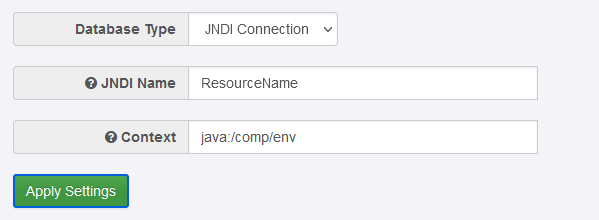Difference between revisions of "JNDI In Fusion Registry"
(→Setting in the Registry User Interface) |
(→Elements of the Resource) |
||
| Line 6: | Line 6: | ||
The following items must exist within the resource: | The following items must exist within the resource: | ||
* name - used to refer to the resource from the UI | * name - used to refer to the resource from the UI | ||
| − | * driver class name - this must be a valid Java | + | * driver class name - this must be a valid Java package (see below) |
* url - the connection string used to connect to the database | * url - the connection string used to connect to the database | ||
* Username and password - to authenticate with the database (optional) | * Username and password - to authenticate with the database (optional) | ||
Revision as of 08:56, 10 November 2021
Contents
Overview
Fusion Registry 10.8.0 supports JNDI connections for storing structural metadata and for Data Stores
Elements of the Resource
The following items must exist within the resource:
- name - used to refer to the resource from the UI
- driver class name - this must be a valid Java package (see below)
- url - the connection string used to connect to the database
- Username and password - to authenticate with the database (optional)
Example driver Class Names
The following are driver class names you should use to connect to various databases:
| MySQL | com.mysql.cj.jdbc.Driver |
| Oracle | oracle.jdbc.driver.OracleDriver |
| SQL Server | com.microsoft.sqlserver.jdbc.SQLServerDriver |
Optional Resource Elements
For non JNDI connections the following settings are set by default:
- TimeBetweenEvictionRunsMillis = 7200000
- MinEvictableIdleTimeMillis = 3600000
- MaxTotal = 10
- MinIdle = 5
- DefaultAutoCommit = false
- MaxWaitMillis = -1
It may be sensible to ensure your resource also sets the values as the above
Applying to a Tomcat Instance
Create or edit the file config.xml and place this in the directory conf.
Restart your Apache Tomcat instance. To use a resource defined in config.xml, refer to the resource name in the Registry User Interface.
Example File
The following shows an example of a valid context.xml file. This example declares 2 resources "jdbc/test1" and "test2" both of which are MySQL resources.
<?xml version="1.0" encoding="UTF-8"?>
<Context>
<Resource
name="jdbc/test1"
auth="Container"
type="javax.sql.DataSource"
maxActive="100"
maxIdle="30"
maxWait="10000"
driverClassName="com.mysql.cj.jdbc.Driver"
url="jdbc:mysql://localhost:3306/fr-soap-ui?useLegacyDatetimeCode=false&serverTimezone=Europe/London"
username="root"
password="myPassword"
/>
<Resource
name="test2"
auth="Container"
type="javax.sql.DataSource"
maxActive="100"
maxIdle="30"
maxWait="10000"
driverClassName="com.mysql.cj.jdbc.Driver"
url="jdbc:mysql://localhost:3306/fusion_registry_temp2?useLegacyDatetimeCode=false&serverTimezone=Europe/London"
username="root"
password="myPassword"
/>
</Context>
Setting in the Registry User Interface
To specify JNDI as the database name, either on the install pages or on the settings page: Settings -> Server Settings -> Database
In the dropdown select "JNDI connection"
In the fields enter the JNDI name and the context
The values should be:
- JNDI Name - this must be the name exactly as specified in the resource. E.g. for Apache Tomcat and the examples above of the context.xml file, this could be either jdbc/test1 or test2
- Context - this is where the Registry will look for the resources. If using Apache Tomcat this value must be specified as java:/comp/env
Troubleshooting
Error: Unable to determine Java Driver class from JNDI information.
This manifests itself with the error message:
Unable to determine Java Driver class from JNDI information. Cannot create JDBC driver of class 'oracle.jdbc.driver.OracleDriver' for connect URL 'jdbc\:oracle\:thin\:@localhost\:1521/orapdb1' No suitable driver
Possible Fix 1: Your Tomcat has not been supplied with the appropriate Oracle driver. Copy the jar file (ojdbc8.jar) to the 'lib' directory of Tomcat.
Possible Fix 2: Your "url" is incorrect and this is causing the issue. Look at your context.xml file and ensure that your "url" is specified correctly in your resource.
